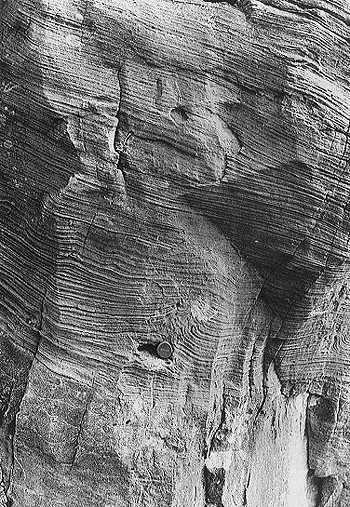
Dewatering structures
Plate 112

Dewatering structures
Plate 112
When sand liquefies, all preexisting structures are canceled. Injecting sand does not necessarily reach the surface, even though it tries to; it can form blind injection structures within buried beds (see inset to plate 110). These bodies are sheetlike, and are called sand dikes, or sedimentary dikes, if they cross the beds, or sedimentary sills if they intrude along bed surfaces. The terms derive from the igneous equivalents, caused by magma injections. Dikes can utilize previous fractures but in most cases are created by the fluid pressure itself (hydraulic fracturing). The "mother bed" of liquefied sand is thinned or reduced to discontinuous lenses; it can also disappear completely.
If liquefaction does not occur or aborts, only water escapes upwards through the porous sediments. It can do it gently, without displacing the grains, or with a violent, turbulent motion, in which case it entrains solid particles (elutriation) or deforms the sediment along its path. Water escape or dewatering structures will be the result. They are frequent in sands that accumulate quickly through catastrophic processes, as in the turbidite bed shown here, but can be also found in tractive deposits of shallow marine and alluvial environments (see color photo 6), especially in loosely packed levels. Dewatering structures are regarded as seismites by some geologists who ignore caution in labeling things (see caveat in commentary on plate 110).
The example reported here, from Eocene turbidites of Guipuzcoa Flysch near San Sebastian (Spain), shows that water expulsion was related to a depositional event. Blind deformations are here observed (they die out within the bed). In the lower, coarse portion, a faint lamination is visible; it is distorted by dish structures (see next two plates). In the overlying laminated sandstone, isolate cusplike structures occur; they pass upwards to attenuated undulations and eventually to a thick interval of plane-parallel laminae. In essence, water escape started as a massive phenomenon and faded out as more and more sediment was being deposited. At the beginning of deposition, the sand was more permeable, and the sedimentation quicker and more massive; higher up in the bed, both permeability and rate of sedimentation decreased.